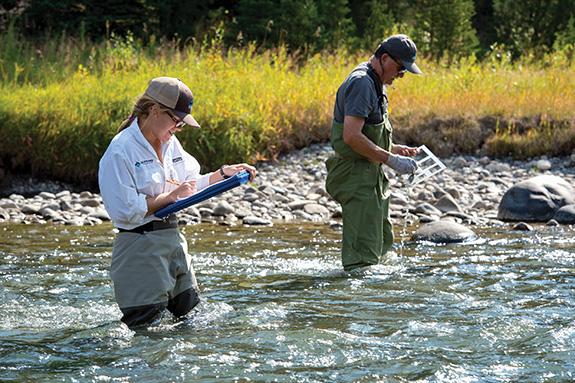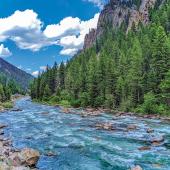River Right
A plan to protect Big Sky’s water.
As the days grow longer and warmer, our local rivers roar back to life after a long, quiet winter. Paddlers and anglers return to enjoy the abundance of water. Soon, the rivers’ roar will turn to a hypnotic song as summer settles in, streamflows wane, and temperatures climb.
Summer temperatures have been increasing over the last 60 years, a trend that promises to continue. These rising temperatures threaten our cold, abundant waters that support diverse wildlife, free-flowing rivers, and world-class recreational opportunities. Increasing resident and visitor populations exacerbate these threats.
Growth further strains water resources by increasing foot traffic along riverbanks, water withdrawals from aquifers that feed streams, and wastewater to be treated and recycled. However, communities can take charge and minimize impacts through comprehensive planning founded on sound science and local knowledge.
The Big Sky community, which sits atop both the Gallatin and Madison watersheds, recently completed such a plan. Over a year and a half, a diverse group of stakeholders convened in Big Sky to unify water management in an area with no central government and situated in two watersheds and counties. Conservationists, community organizations, developers, recreation professionals, and state and local government developed creative solutions to complex water issues.
On the Gallatin side of the Big Sky community, current and past land-use practices and increasing recreational pressures have elevated levels of nutrients, algae, and sediment in some streams, and damaged streamside vegetation. On the Madison side, conditions are generally good; however, since significant development is slated for this area, proactive measures will be necessary to maintain healthy waters.
Together, the stakeholders crafted a shared vision for Big Sky: to be a model mountain community by protecting and improving water resources, sustaining ecological health of the watersheds, and supporting a vibrant local economy.
Plan recommendations support one or more of these key concepts:
Understand and track the ecological health of river systems. A detailed understanding of trends and impacts to water quality, water supply, streamflows, groundwater recharge, riparian and wetland health, and instream habitat and fisheries is essential to track progress and develop restoration projects.
Maximize valuable limited water supply. Conserve water and recycle highly-treated wastewater for other uses such as landscape irrigation and snowmaking at Big Sky Resort and the Yellowstone Club.
Slow the flow of water through the watershed. Use thoughtful stormwater management and targeted wetland and riparian restoration projects to enhance low late-season streamflows.
Address existing impacts. Undertake restoration projects based on scientific data, like the those recently completed on the West Fork of the Gallatin and Moose Creek Flat Recreational area, where boat launches were rehabilitated and streambanks were shored up.
Preserve and enhance high quality water resources. Maintain and enhance stream, riparian, and wetland areas to prevent of further cumulative impacts preserving high water quality, fisheries, wildlife and scenic values, and support the recreation-based economy.
Success will require strong community engagement, partnerships, and support from larger players like developers, resort areas, and conservation organizations down to individual recreational users of our rivers. To learn more about the recommendations from this comprehensive planning effort, visit gallatinrivertaskforce.org.
Kristin Gardner is the executive director of the Gallatin River Task Force.











